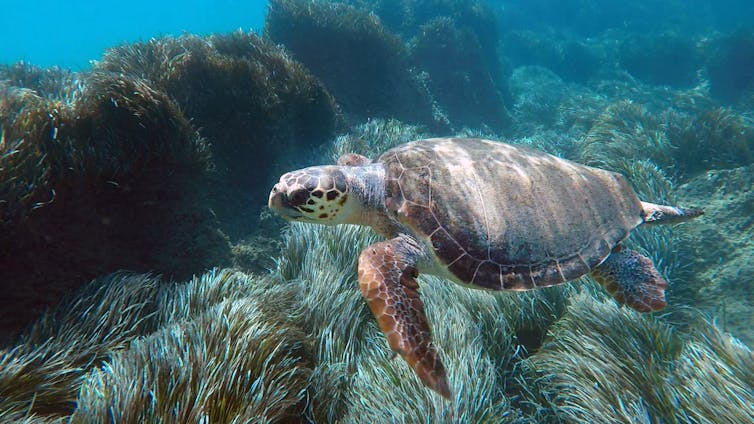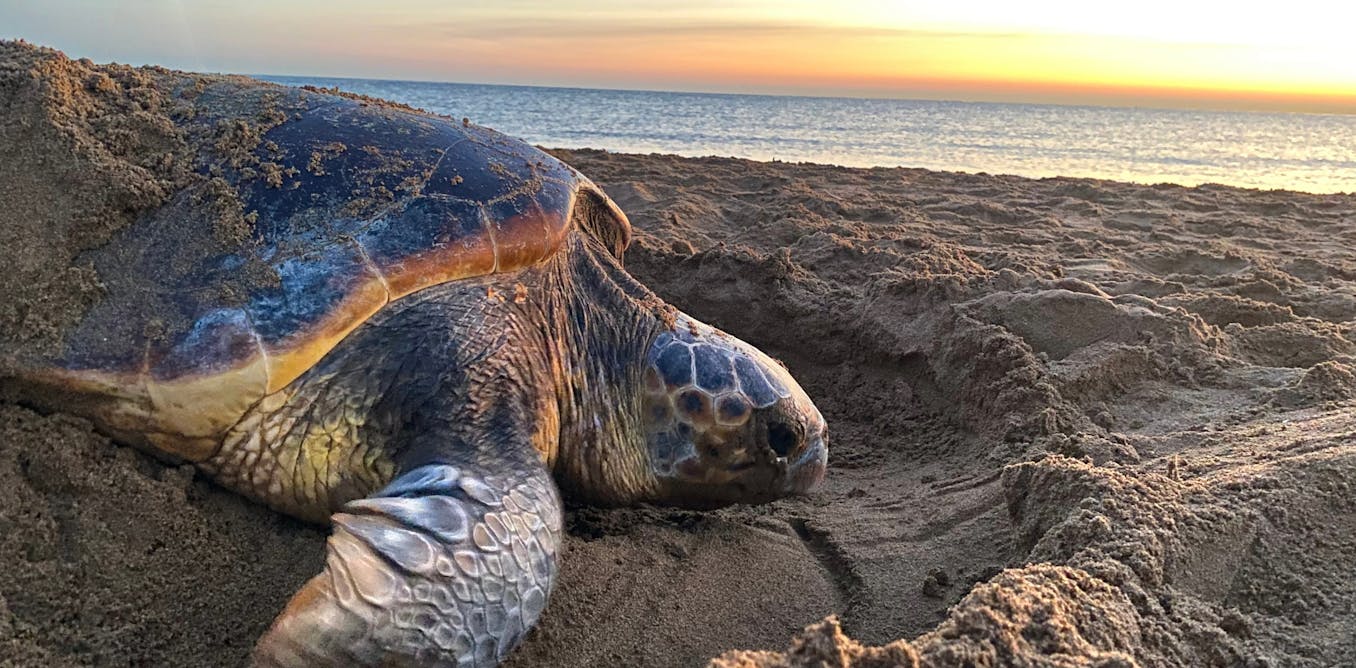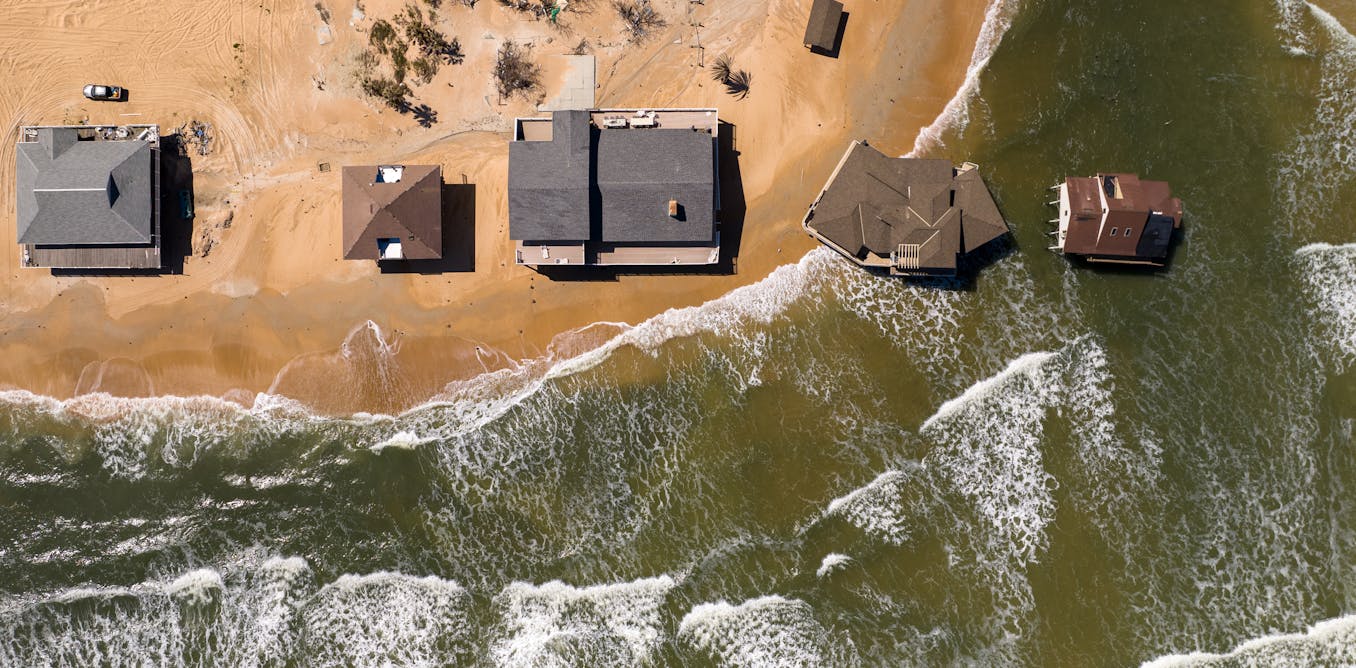Rising global temperatures are a particularly acute threat for the world’s sea turtles. That’s because the temperature of a turtle’s nest controls the sex of their offspring.
Coming ashore onto a beach (often the beach from where they hatched), sea turtles use their flippers to carefully scoop out the sand and create flask-shaped nests in the sand in which they lay their eggs. There is no maternal care for these nests – their success depends solely on the environment. Hotter nests will produce more female hatchlings, but fewer babies will survive into adulthood once temperatures rise above a critical threshold.
Unless sea turtles find a way to counteract rising nest temperatures, climate change could produce an increasing number of females and fewer offspring – a frightening scenario for sea turtle biologists like us.
Fortunately, we were pleased to discover that green and loggerhead turtles that breed in North Cyprus are arriving earlier in the year to offset some of the impacts of rising incubation temperatures.
Matt Wall
Since the early 1990s, the Society for the Protection of Turtles and our team at the University of Exeter have been working together to monitor and protect the green and loggerhead turtles that nest on the beaches of North Cyprus.
Every summer, a team of dedicated volunteers patrols nesting beaches to record every nest that has been laid. They place temperature data-loggers into these nests and tag every female they encounter. The result is a unique database of over 1,300 individual female turtles for whom the date, location and hatching success of her nests is known.
Using this database, we were able to show that, since 1992, green and loggerhead turtles in North Cyprus are nesting more than half a day earlier each year (greens 0.61 days, loggerheads 0.78 days). Before the mid 2000s, no turtles had been recorded nesting before June, but now we expect to see quite a few nests from the start of May.

Do the seasons feel increasingly weird to you? You’re not alone. Climate change is distorting nature’s calendar, causing plants to flower early and animals to emerge at the wrong time.
This article is part of a series, Wild Seasons, on how the seasons are changing – and what they may eventually look like.
If temperatures keep rising at current rates, we estimated that to maintain current sex ratios, the loggerhead turtles would need to keep nesting half a day earlier each year. To prevent a decrease in hatching rates, they’ll need to nest 0.7 days earlier each year.
This means that, for the time being, our loggerheads are shifting their nesting dates early enough to maintain current incubation temperatures and, therefore, sex ratios and hatching success. Good news.
Though our study in loggerheads offers cause for optimism, there is no guarantee that the females will continue to nest earlier and earlier each year. To try to understand if this might be the case, we wanted to understand whether temperature was the main factor driving this earlier nesting.
Temperature isn’t everything
For individual green turtles, we confirmed that the temperature is an important factor in causing them to nest earlier. In fact, we found that individual females will nest 6.47 days earlier for every degree celsius increase in sea temperature.
However, we also showed that how many times a female has bred before and the number of times she lays eggs in a breeding season explain an equal amount of the variation in her lay dates. These observations have important effects when we think about what is happening to the green turtle population as a whole.

Brad Clarke
As a result of conservation measures such as protecting the nests from predation and relocating nests laid too close to the high water line we have seen a big population increase in the green turtles at our study site in North Cyprus. Since 1992, numbers have grown from 55 nests per year to over 400.
Understanding the current trend of earlier nesting is complicated. But, for now, we can be assured that sea turtles are doing just enough to counteract the negative effects of climate change – which is fantastic news.
The turtles are doing their bit. Now, it is up to us to ensure the continued conservation and long-term monitoring of this charismatic ocean ambassador to give them the best chance of survival in our changing world.

Don’t have time to read about climate change as much as you’d like?
Get a weekly roundup in your inbox instead. Every Wednesday, The Conversation’s environment editor writes Imagine, a short email that goes a little deeper into just one climate issue. Join the 40,000+ readers who’ve subscribed so far.

The post “Climate change could make more turtles female – but some are starting to adapt” by Mollie Rickwood, PhD Researcher, Marine Conservation, University of Exeter was published on 02/21/2025 by theconversation.com




































Leave a Reply